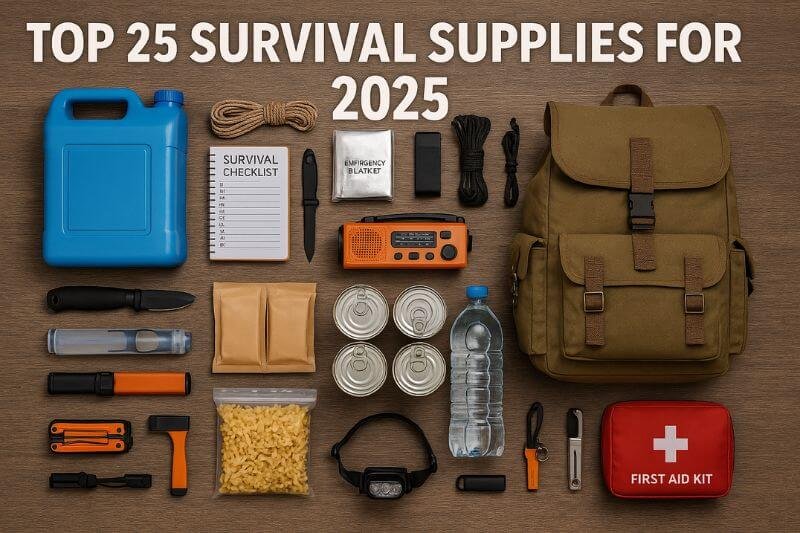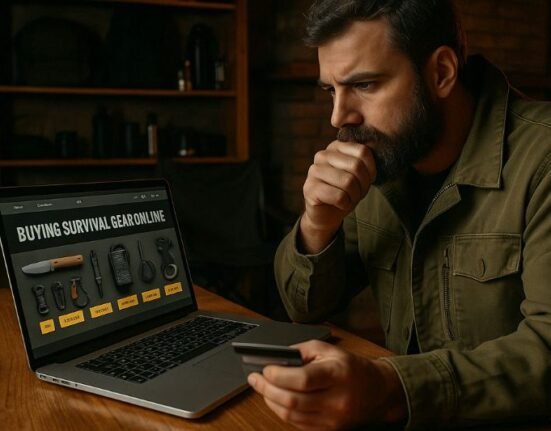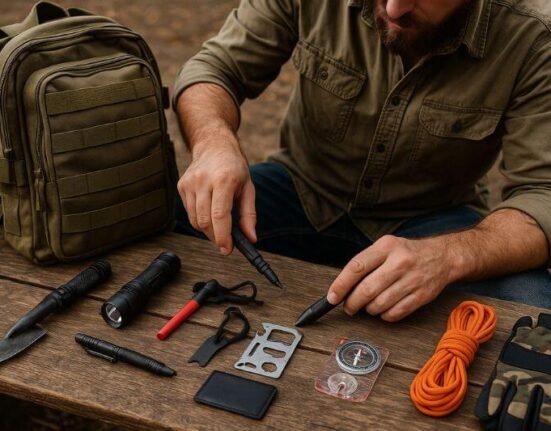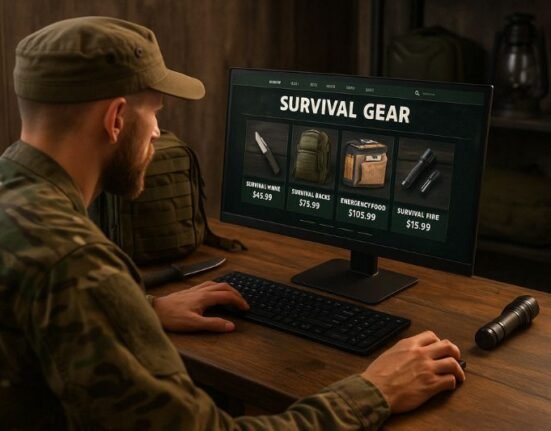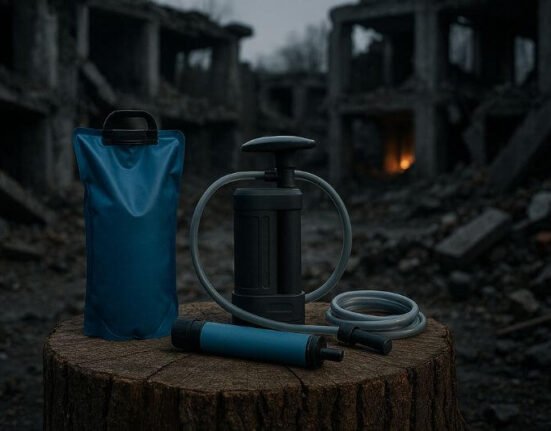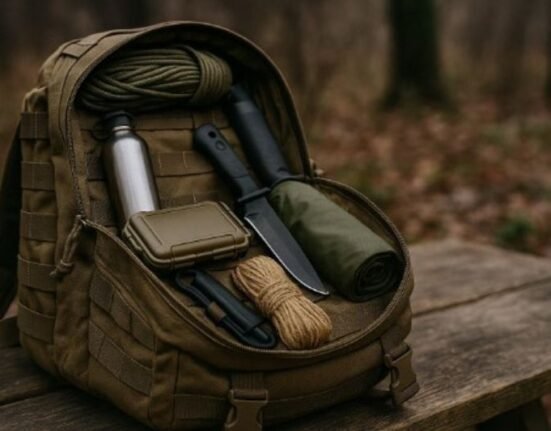Survival supplies are the foundation of any effective preparedness plan, especially in a world where crises are becoming increasingly unpredictable. Whether you’re preparing for natural disasters, social unrest, or long-term grid failures, having the right gear could mean the difference between chaos and control.
In this guide, we break down the 25 essential survival supplies every beginner prepper should secure in 2025 — with practical advice, real-world examples, and expert insights.
Why Survival Supplies Matter More Than Ever
We’re not just talking about doomsday prepping anymore. With extreme weather, pandemics, wars, and cyberattacks on the rise, having a reliable set of survival supplies is now considered common sense, not paranoia.
“Preparedness is no longer a niche concern — it’s a civic responsibility.” — CrisisReady Institute, 2024
In fact, FEMA recommends having at least 72 hours of basic emergency supplies on hand at all times. But for long-term survival, a deeper approach is necessary.
1. Water: The Non-Negotiable Priority
Water is life — literally. You can survive three weeks without food, but only three days without water.
Must-Have Items:
- Water filter (e.g., Sawyer Mini, LifeStraw)
- Water purification tablets
- Collapsible water containers (5–10L)
- Rainwater collection system (if applicable)
🛑 Mistake to avoid: Stockpiling bottled water without a rotation plan. Plastic breaks down over time.
📎 Learn how to store water safely (FEMA)
2. Long-Term Food Storage
A pantry full of perishables won’t cut it in a real crisis. Focus on calorie-dense, shelf-stable foods.
Suggested Supplies:
- Freeze-dried meals (25-year shelf life)
- Canned meats (tuna, chicken, spam)
- Rice, beans, oats (stored in Mylar bags)
- Peanut butter, honey (high-energy)
- Manual can opener
“A prepper’s pantry is only as useful as its diversity and caloric value.” — Urban Survival Guide, 2023
✅ Pro tip: Create a rotating food inventory using the FIFO method: First In, First Out.
3. Fire Starters & Cooking Supplies
Fire means heat, food, light, and morale.
Essentials:
- Ferrocerium rod
- Waterproof matches
- Butane lighter
- Portable stove (e.g., Jetboil, Biolite)
- Solid fuel tablets or alcohol burners
- Cookware (preferably stainless steel)
🔥 Good practice: Test all gear at least once in real conditions. Avoid relying on a single ignition method.
4. First Aid & Medical Gear
When emergency services are overwhelmed or unavailable, basic medical supplies become survival tools.
Basic Kit Checklist:
- Adhesive bandages, gauze, antiseptic wipes
- Antibiotic ointment, burn cream
- Pain relievers (ibuprofen, acetaminophen)
- Tweezers, scissors, gloves
- Emergency trauma supplies (tourniquet, Israeli bandage)
💡 Consider adding prescription meds, electrolyte tablets, and a printed medical guide like “Where There Is No Doctor”.
5. Emergency Power Sources
Grid failures are common during disasters. Ensure you have redundant ways to generate power.
Power Options:
| Source | Best For |
|---|---|
| Solar power bank | Phones, flashlights, radios |
| Hand crank radio | Emergency weather updates |
| Battery banks | Charging small electronics |
| Solar generator | Larger gear (fridge, laptops) |
🔋 Expert tip: Always test and recharge batteries monthly.
6. Shelter and Warmth
Staying warm and dry is a survival priority, especially in cold or wet climates.
Don’t Forget:
- All-season tent or tarp
- Emergency Mylar blankets
- Sleeping bag (rated for your climate)
- Wool socks and gloves
- Poncho or rain gear
“Hypothermia can kill faster than hunger in survival scenarios.” — Red Cross Field Manual
7. Tools and Multipurpose Gear
Versatility is key. These tools solve multiple survival problems at once.
Must-haves:
- Survival knife (fixed blade)
- Multi-tool (Leatherman or Gerber)
- Paracord (at least 50 ft)
- Duct tape
- Hatchet or folding saw
🧰 Checklist: Carry tools in a waterproof case or roll-up pouch for easy access.
8. Lighting & Visibility
Disasters often knock out the grid. You’ll need multiple light sources and backups.
Lighting Options:
- Headlamps (hands-free use)
- LED lanterns
- Solar garden lights (low-cost alternative)
- Glow sticks
- Flashlight with strobe (for signaling)
🔦 Best practice: Keep one light in each room of your home, ready to go.
9. Hygiene & Sanitation Supplies
Sanitation breakdown is a major threat during long-term crises.
Key Items:
- Wet wipes and dry shampoo
- Biodegradable soap
- Toothbrush/toothpaste
- Feminine hygiene products
- Trash bags + bleach for makeshift toilets
🛁 Stay clean to stay healthy — infections spread fast when sanitation is ignored.
10. Communication Tools
When networks go down, alternative communication becomes critical.
Essentials:
- Hand-crank or battery-powered emergency radio (NOAA enabled)
- Two-way radios (FRS/GMRS)
- Whistle (for signaling)
- Laminated contact card (for loved ones)
📡 Pro tip: Learn how to access emergency frequencies before disaster strikes.
11. Clothing & Footwear
Forget fashion — focus on durability and adaptability.
Items to include:
- Sturdy boots (water-resistant)
- Layered clothing system (base, mid, outer)
- Thermal underwear
- Balaclava or shemagh
- Work gloves
🧤 Always keep an extra outfit in your bug-out bag.
12. Documentation & Emergency Plans
When things go south, documentation saves time and lives.
📁 Keep copies of:
- ID and insurance cards
- Emergency contacts
- Evacuation routes
- Local shelter maps
- Printed survival manuals
📝 Store documents in a fireproof waterproof pouch.
13. Bartering and Defense Supplies
In extreme collapses, the value of goods skyrockets. Some items double as currency.
Barterables:
- Lighters
- Batteries
- Alcohol mini bottles
- Ammunition
- OTC meds
🛡️ For defense, ensure your tools are legal, safe, and familiar to you. Knowledge always trumps gear.
14. Survival Manuals & Skill Guides
Knowledge weighs nothing. Printed guides can be vital when the internet is down.
📚 Essential Reads:
- “SAS Survival Handbook” by John Wiseman
- “Bushcraft 101” by Dave Canterbury
- Printed guides on first aid, edible plants, knot-tying
“If you can’t remember it, you better have it printed.” — Field Survival Course, 2024
📝 Store in a dry bag or waterproof folder.
15. Pest Control and Insect Protection
Insects can ruin shelter environments or contaminate food supplies.
Include:
- Mosquito net
- DEET-based insect repellent
- Fly traps or citronella candles
- Diatomaceous earth (natural insecticide)
🦟 In tropical or forested zones, protection from bugs is not optional.
16. Seed Bank for Long-Term Survival
For real long-haul prepping, think beyond stockpiling — grow your own food.
🌱 Key items:
- Non-GMO heirloom seeds (sealed)
- Quick-growing crops (radish, lettuce, beans)
- Gardening tools (small trowel, gloves)
The WHO encourages local food growing as part of food security strategies.
✅ Pro tip: Test your seeds before crisis hits. Germination is not guaranteed after long storage.
17. Fuel & Firewood Backup
If you rely on fuel or heat to cook or survive the cold, you’ll need reserves.
⛽ Store:
- Propane tanks or butane cartridges
- Firewood (dry, sealed)
- Fuel stabilizer for gas-powered tools
- Charcoal and waterproof storage bins
🚫 Never store fuels near sleeping areas — fire and fumes are silent killers.
18. Backup Eyewear and Vision Protection
If you wear glasses or contacts, vision failure in a crisis can be crippling.
👓 Include:
- Spare prescription glasses
- Lens wipes
- Non-prescription safety goggles
- Sunglasses for sun and snow glare
✅ Store in a hard case and rotate every few years as your prescription changes.
19. Infant or Elderly-Specific Supplies
Your kit must match the real people in your household, not a theoretical prepper.
🧴 Possible additions:
- Baby formula, diapers, wipes
- Mobility aids, incontinence items
- Specialized medications
- Easy-to-open food pouches
📎 FEMA’s guide for people with disabilities and older adults
20. Pet Emergency Kit
Pets are family. Don’t forget their needs in your survival planning.
🐾 Pet kit includes:
- 3 days of pet food
- Leash, harness, collapsible bowl
- Vaccination papers
- Comfort toy or blanket
✅ Label pet items clearly and store in an easy-grab tote.
21. Waste Management Tools
When toilets stop working, the problem becomes immediate — and hazardous.
🚽 Include:
- 5-gallon bucket + toilet seat lid
- Heavy-duty trash bags
- Lime or bleach for odor and sanitation
- Privacy shelter or pop-up tent
⚠️ Improper sanitation can lead to disease outbreaks within days.
22. Protective Masks and Respiratory Gear
Smoke, dust, or chemical leaks can compromise breathing quickly.
😷 Respiratory protection:
- N95 or P100 masks
- Wet cloth bandana (minimal fallback)
- Full-face respirator (for urban preppers)
- Goggles for eye protection
💨 Consider risks in your area: wildfires, chemical plants, volcanic zones.
23. Cash in Small Denominations
ATMs may be down and cards useless in the early days of a crisis.
💵 What to store:
- Small bills ($1, $5, $10)
- Coins (for vending machines, laundromats)
- Waterproof cash bag or belt pouch
“Cash is king during the first 72 hours of any disaster.” — Economic Preparedness Survey, 2023
24. Situational Awareness Gear
Seeing without being seen is a huge advantage.
🔍 Gear to consider:
- Binoculars (compact or night vision)
- Signal mirror and periscope
- Reflective patches (or blackout for stealth)
- Notepad for recon sketches
⚠️ Don’t underestimate the value of observation in chaotic environments.
25. Community & Skill-Sharing Assets
Prepping in isolation only works to a point. Local community = resilience.
🧩 Ideas to build:
- Contact list of local preppers or trusted neighbors
- Barter-friendly skills (first aid, mechanical repair, food preservation)
- Emergency meet-up plan
- Skills binder or USB backup with guides/videos
🌐 Consider joining or creating a local preparedness network — mutual aid saves lives.
Final Conclusion: The Survival Supplies You Can’t Afford to Ignore
Whether you’re bracing for blackouts, conflict, or climate chaos, the 25 survival supplies listed here provide a solid foundation for any beginner prepper.
Each item solves a vital problem: hydration, shelter, communication, protection. Start small, plan smart, and revisit your kit every few months.
👉 What’s next?
➡️ Download our Free Printable Survival Kit Checklist
➡️ Explore our in-depth guides on bug-out plans and emergency food storage
Preparedness isn’t panic — it’s peace of mind.









